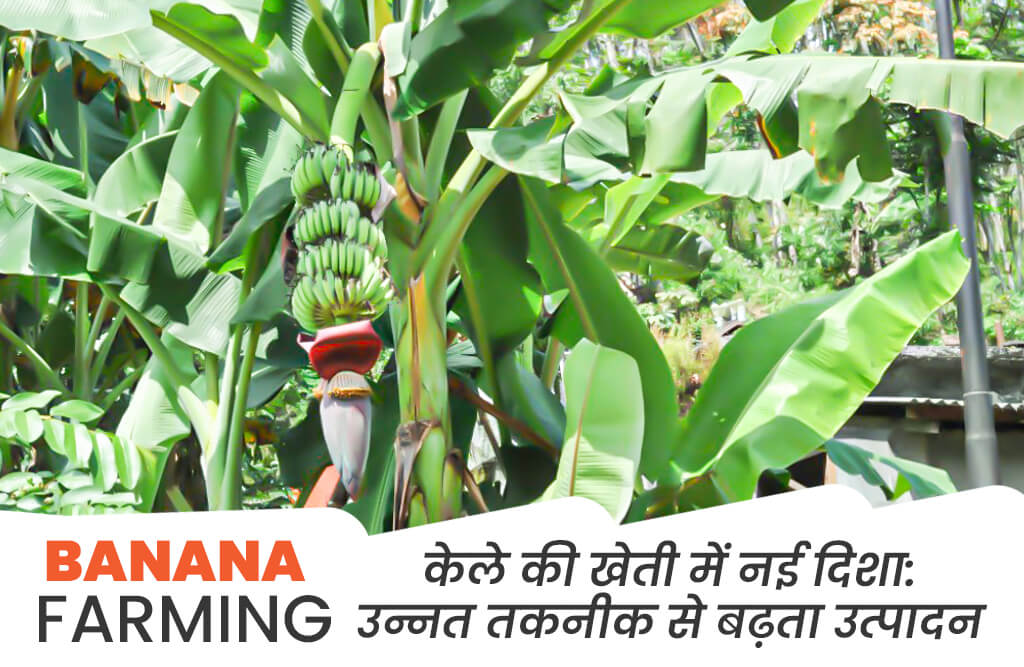
In India, Maharashtra boasts the highest banana productivity, followed by other notable banana-producing states such as Karnataka, Gujarat, Andhra Pradesh, and Assam. The substantial banana output presents a challenge for farmers in cultivating bananas without the use of chemicals. Bananas, ranking as the second most crucial fruit crop in India after mangoes, are favored by people across all demographics due to their year-round availability, affordability, diversity, taste, nutritional richness, and medicinal value.
Banana is a predominantly tropical crop that thrives well in temperatures ranging from 13ºC to 38ºC, with a relative humidity of 75-85%. It is sensitive to high temperatures, exacerbated by winds exceeding 80 km per hour, which can cause damage to banana plantations. Successful banana cultivation requires well-draining soil, adequate nutrition, and proper moisture content. The soil should maintain a balanced pH, rich in organic matter, with optimal levels of nitrogen, phosphorus, and potassium for optimal banana growth.
Banana is cultivated across various regions and production systems in India. Consequently, the selection of varieties is based on a large number of types that cater to different needs and conditions. While there are approximately 20 varieties, including Dwarf Cavendish, Robusta, Monthan, Poovan, Nendran, Red Banana, Nyali, Safed Velchi, Basrai, Ardhapuri, Rasthali, Karpooravalli, Karthali, and Grand Nain, among others. Grand Nain is gaining popularity due to its resistant nature and might soon become the most favored variety. It features sturdy hands with straight orientation and a large size.
Prior to planting bananas, the land should be plowed 2-4 times and leveled. To break clods and thoroughly dig the soil, a rotavator or harrow can be employed. During soil preparation, essential F.Y.M. manure is introduced and well-mixed with the soil. The appropriate placement and depth for planting seedlings depend on the soil's surface layer. Keeping a spacing of 1.8x1.5 meters between banana plants yields approximately 1452 plants per acre. Alternatively, a spacing of 2 meters x 2.5 meters between plants accommodates about 800 plants per acre. Banana cultivation is well-suited for regions with warm to moderate climates, and areas with higher rainfall are particularly favorable for banana farming.
Banana is a widely consumed fruit due to its affordability and high nutritional value. It is consumed both in its fresh and ripe forms. Banana is a rich source of carbohydrates, particularly abundant in Vitamin B. It also serves as a good source of potassium, phosphorus, calcium, and magnesium. This fruit is easily digestible, low in fat, and cholesterol-free, making it beneficial for health. It is recommended for individuals suffering from conditions like high blood pressure, arthritis, ulcers, GI tract issues, and kidney diseases.
The Ripening Process and Yield of Bananas: To ripen bananas, containers are placed in a closed room, and bananas are covered with banana leaves. A fire is ignited in one corner, and the room is sealed with soil. In approximately 48 to 72 hours, the bananas are ready for consumption. The crop, once planted, becomes harvest-ready within 11-12 months of planting. The initial harvest is expected within 8-10 months after the primary crop is harvested, and the second harvest is anticipated 8-9 months after the subsequent crop. Utilizing drip irrigation and fertilization, banana yield can reach up to 100 MT/hectare from an elevated perspective.
Increase Banana Yield in This Manner: For enhancing banana yield, a farmer can distribute 450 grams of urea and 350 grams of muriate of potash, dividing it into five parts. Afterward, apply it to each plant five times. To achieve a good harvest from the banana crop, it is essential to choose improved varieties. This ensures better yields.
Banana-Based Products Baby Food, Health Drink, and Soup Mix: India is the world largest banana producer, contributing 25 percent to global production. During surplus market sales, the abundant banana production can be effectively utilized to create value-added products like Banana Baby Food, Health Drink, and Soup Mix, which can command premium prices in the market. Banana flour, prepared from bananas, milk, green gram, and sugar, is fortified to prepare a nutritious meal for infants. Meanwhile, for making health drinks, banana flour is combined with chocolate powder, barley powder, and sugar. In the case of soup mix, banana flour is blended with corn flour, dried vegetables, and spices in varying proportions. Banana-based baby food is suitable for growing children, and health drinks and soup mixes cater to all age groups. These products can be stored for up to six months."